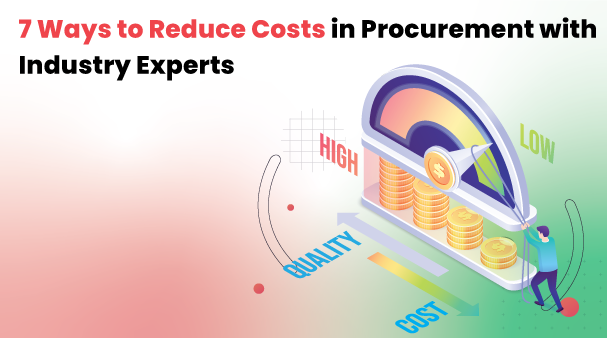What Is Procurement?
Procurement includes activities a business performs for obtaining goods (or services) from vendors and suppliers. The process ensures that the purchases are of high quality and appropriate quantity, acquired from the right source at the right time at the right costs.
Procurement plays a very important role in optimising business performance for every organisation involved in acquiring goods and services. Current procure-to-pay processes aim to achieve procurement cost reduction, expedited product development, and quality assurance. It is important to achieve performance improvement for the entire supply chain, especially during procurement.
This article covers procurement and seven ways to reduce procurement costs in businesses with industry experts.
Factors that drive procurement strategy, processes, and execution include:
- Cost efficiency
- Information resources availability
- Market competition
- Evolving customer requirements
- Identifying and mitigating risks in supply
Organisations need to establish robust procurement and supply chain management strategy. Procurement can be considered a holistic approach for identifying, planning, and acquiring the organisation’s needs.
Costs Drivers in Procurement
It is important to understand the drivers in procurement that help in procurement cost reduction and improve the quality of the procure-to-pay process. Some of them are:
- Materials: The materials used during the procurement process and their quantity
- Product components:The number of components and their material, design, and packaging
- Overhead costs:The costs of maintaining and repairing the facilities and machinery
- Labour costs:The costs involved in employing the workforce, efficiency rate, and the methods used in manufacturing
- Product transportation:The logistics used for transporting materials, components, and finished products
- Product research and development:Thorough product research and development in markets where innovation is needed
- Admin costs:Administration, sales, and other admin costs
7 Strategic Ways to do cost reduction in Procurement
Cost-saving measures aim to reduce the overall procurement costs. It is also important to reduce the unnecessary purchasing process expenses.
Here are some of the best strategies with which you can reduce the procurement costs:
1. Use Of Technology
Upgrade your company’s purchasing process to business process automation, which will result in cost-saving, efficient purchasing, and conducting spend analysis. Using procure-to-pay (P2P) software to link purchasing systems with inventory management and accounting ensures accuracy in expense reporting and reduces the time spent analysing.
2. Improve Vendor Relationship
Improve communication between your organisation and the vendor. Make sure you evaluate their performance time-to-time as per your suppliers’ standards, improving the deliverables while reducing costs.
3. Gather Data
Collecting accurate data improves procurement forecasting, helps businesses purchase goods and services at the best prices, better customer understanding, and reduces unnecessary spending with real-time reporting. A centralised procurement data system streamlines data insights and lowers procurement costs.
4. Procurement Workflow Automation
Procurement automation reduces labour costs by eliminating the routine tasks and invoice processing and avoids chances of encountering errors by selecting optimal vendors and reducing the cash leaks. It automates manual, repeatable, and labour-intensive procurement process tasks. The procurement team can focus on business activities that accelerate the processing and reduce errors by executing the procurement workflows.
5. Review Non-competing Suppliers
Perform a benchmarking process to review the contracts highlighting suppliers in your database that aren’t competitive. Communicate a request to reduce costs. Alternatively, you can replace them by approaching better suppliers to aid in the procurement savings and efficient process.
6. Reduce Risks In Procurement
Risk management is a broad strategy often managed at the corporate level. Risk management in procurement ensures correct management controls for the purchases. A risk mitigation plan reduces the supplier’s dependence on a critical item or service. Managing the risk is also synonymous with avoiding costs, leading to better savings and value from the existing contracts.
7. Review Contract Terms
Make it a common practice to challenge and revise the existing contract and payment terms for savings opportunities. Discussions with all the suppliers about changes in the purchasing frequency can help get voluminous discounts by changing the purchasing patterns.
How does WeP P2P help businesses to reduce their procurement costs?
- WeP offers the best Procure to Pay Software in the procure-to-pay process, eliminating all the sources of friction in the procurement process right from order placement to payment.
- Our procure-to-pay solution standardises every step of the procurement cycle, making product acquisition easier by automating purchase requests and orders, receipts, and invoices
- Features that we offer with our procurement services.
- Quick purchase requests approval
- Quality checks
- Centralized vendor database
- Frees up employees’ time which automating the tasks
4. WeP Digital comes as a perfect solution for empowering your procurement and supply chain department.Thinking of the best procurement automation solution? Think WeP Digital.

